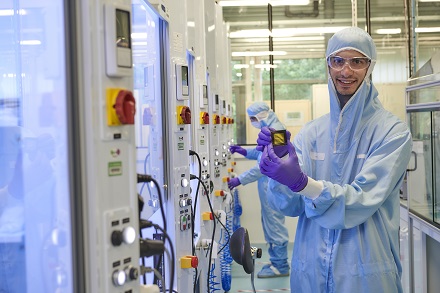What is the share of solar energy in Europe?
To
reduce its greenhouse gas emissions to at least 55% by 2030 in order to achieve its climate neutrality goal by 2050, the European Union has been pushing to significantly increase the renewable energy share in Europe’s energy mix. Climate targets bring EU countries closer together even though they have own national energy mix policies1 that may differ in detail. Among the renewable energy sources supported by the EU,
solar PV is currently at the top of its game with its ever-growing market; the number of solar PV facilities installed in Europe skyrocketed in 2021.
![The year 2021 has been a record-breaker for the European solar power sector, exceeding the highest score reached in 2011 [Solar Power Europe] © M. Colonna d'Istria / CEA graphique cea.jpg](/english/PublishingImages/Pages/News/solar-pv-an-advantage-for-europe/graphique%20cea.jpg)
The year 2021 has been a record-breaker for the European solar power sector, exceeding the highest score reached in 2011 [Solar Power Europe] © M. Colonna d'Istria / CEA
What are the advantages of solar PV?
First,
solar PV facilities can be deployed very quickly. This means that a high generation capacity can be provided swiftly to meet the market demand. Second, it is considered a reliable energy source because it is inexhaustible. Last, solar PV comes at a very low cost, currently at less than $20 per megawatt-hour in countries with strong sunshine. The French President, Emmanuel Macron, announced on 10 February this year in Belfort that he intended to further accelerate the development of renewables in France , specifically solar power since it is less expensive and easier to integrate into the natural environment. The objective is to increase the installed capacity by a factor of 10 to exceed 100 gigawatts by 2050. Even though solar-generated electricity is obviously conditioned by the level of sunshine during the day (France has an average load factor of 14%), it has been seen that the higher the installed capacity, the higher the power production, which is the case in Germany. It is therefore important to maximise the deployment of solar facilities and rebuild France’s solar PV industry.
What is Europe’s solar PV deployment strategy?
The European Union is in favour of speeding up the growth of solar power generation by developing a competitive and robust solar PV industry in Europe across the entire value chain, from the research and development of new PV modules, through to PV manufacturing and electricity generation. Two European organisations are actively working to federate the different European countries around this initiative, i.e.
Solar Power Europe and the
European Solar Manufacturing Council. The majority of solar PV panels are currently manufactured in Asia. The pandemic made the European Union realise just how important it was to bring production facilities back to Europe. It is no longer feasible to depend on major solar PV panel manufacturers like China. The entire PV panel manufacturing and installation chain can be secured by bringing these production means back to Europe. For this reason, the European Commission initiated
a public consultation process in January 2022 to prepare a joint European solar power strategy, which should be ready sometime in summer. This strategy will provide European solar community with the opportunity to find the best industrial, technological and legal solutions together in order to maximise Europe’s solar energy potential. Several initiatives have since emerged over the past two years involving the construction of solar ‘gigafactories’ in Europe. The Italian company Enel Green Power has transformed a former industrial facility in Sicily into a “sun factory”, making it one of the largest PV production plants in Europe using a new-generation heterojunction (HJT) bifacial panel technology.
What R&D actions are being deployed on a European scale and how is the CEA contributing to these developments?
Solar power is a constantly evolving sector. The solar cells used to make PV modules five years ago are no longer in use today. It is constantly necessary to find innovations. At the CEA-Liten Institute, the first European research centre solely devoted to the energy transition, we are helping to develop new-generation solar cells with a much higher level of efficiency that those currently sold on the market. The mass market is currently offering efficiency levels between 22 and 23% for the conversion of sunlight into electricity. We are currently working on a generation of solar PV panels with a maximum efficiency of 25%, while preparing the next generation that is expected to exceed efficiencies of 30%. This is known as a tandem cell approach, which involves combining two types of material, one based on silicon while the other is organic.

Laboratory dedicated to perovskite and tandem cell activities. © D. Guillaudin / CEA
We are also collaborating with our European academic partners on a new PV module project suitable for desert environments, not to mention other research and innovation projects within the scope of the Horizon Europe framework programme. At the same time, we are trying to influence the relevant European directives by supporting the emergence of a solar PV industry to manufacture the modules in the locations where they are to be installed.
We are providing our technical expertise and knowledge of industrial environments through close collaboration with the industry. Europe has everything it needs to build its own solar PV industry and become the leader in this strategic sector, generating numerous employment opportunities and a promising future ahead.
On 2 March 2022, the CEA held a conference on the renaissance of the solar PV industry in Europe, in collaboration with its partners Solar Power Europe and Innoenergy. The purpose of this conference was to highlight their common understanding of solar PV and its importance in carbon neutral policies for 2050. This involves reconciling the European Union’s climate targets with its industrial ambitions, while analysing the options making it possible to consolidate Europe’s technical, innovation and industrial capacities in this sector.